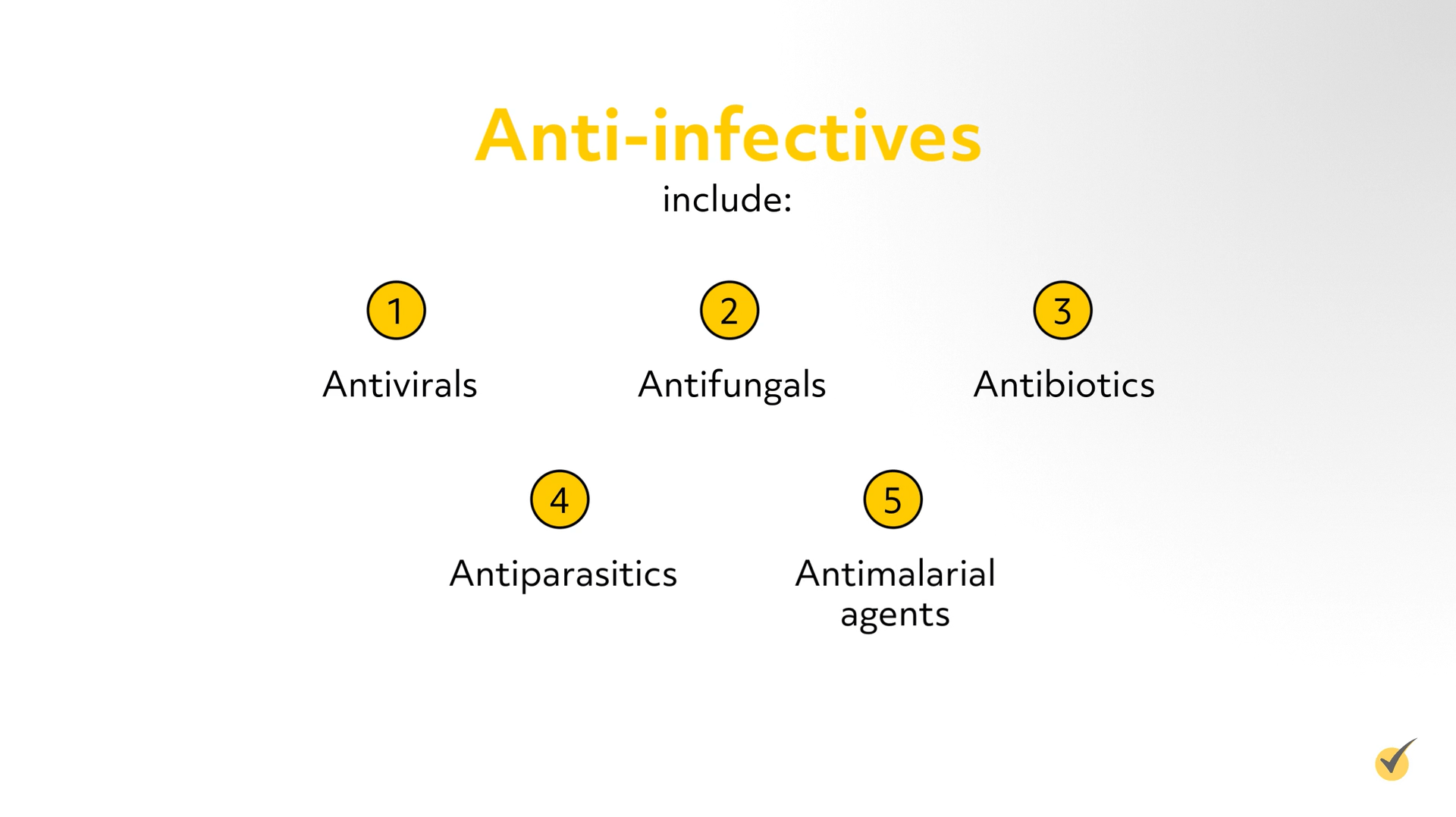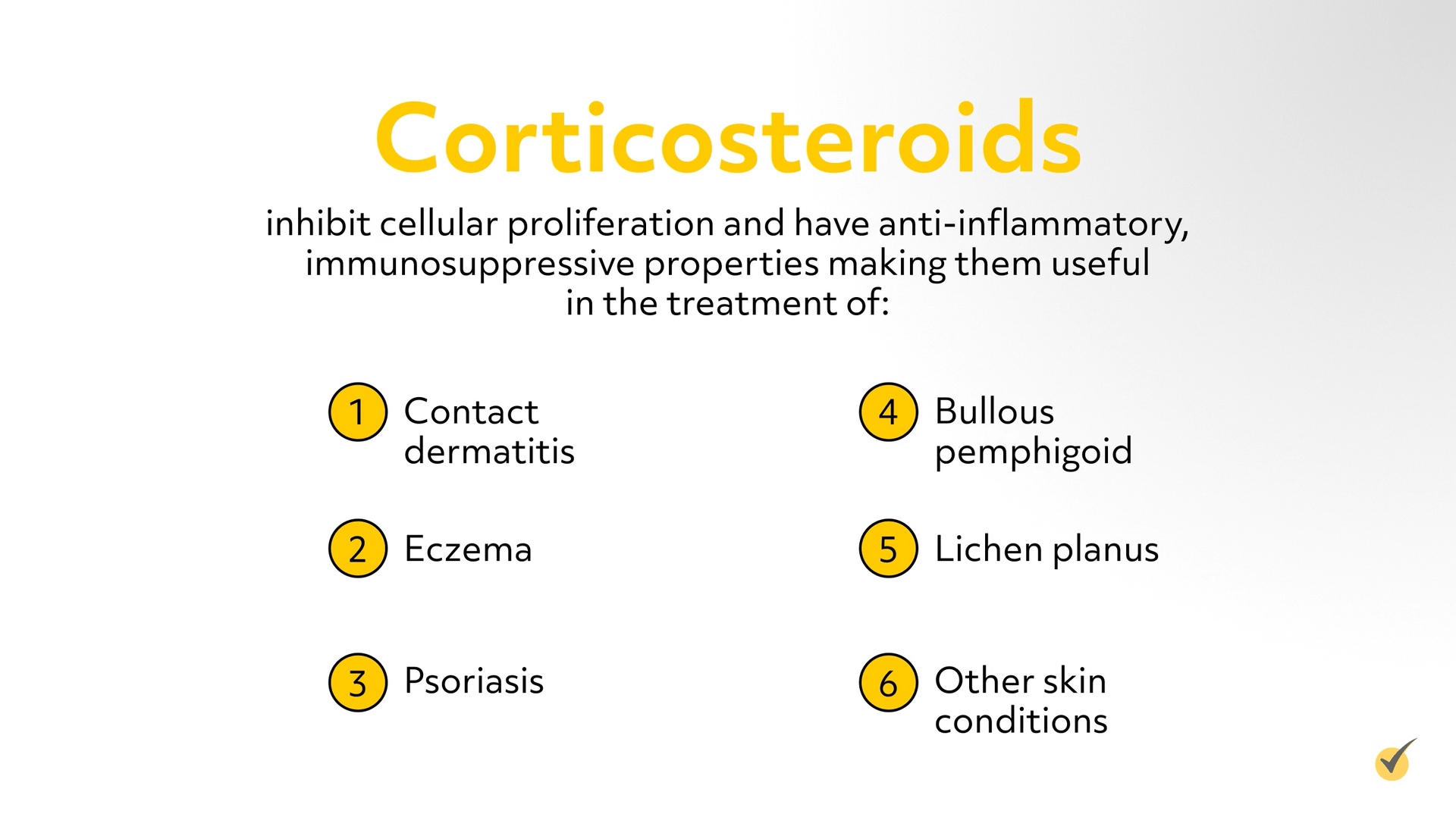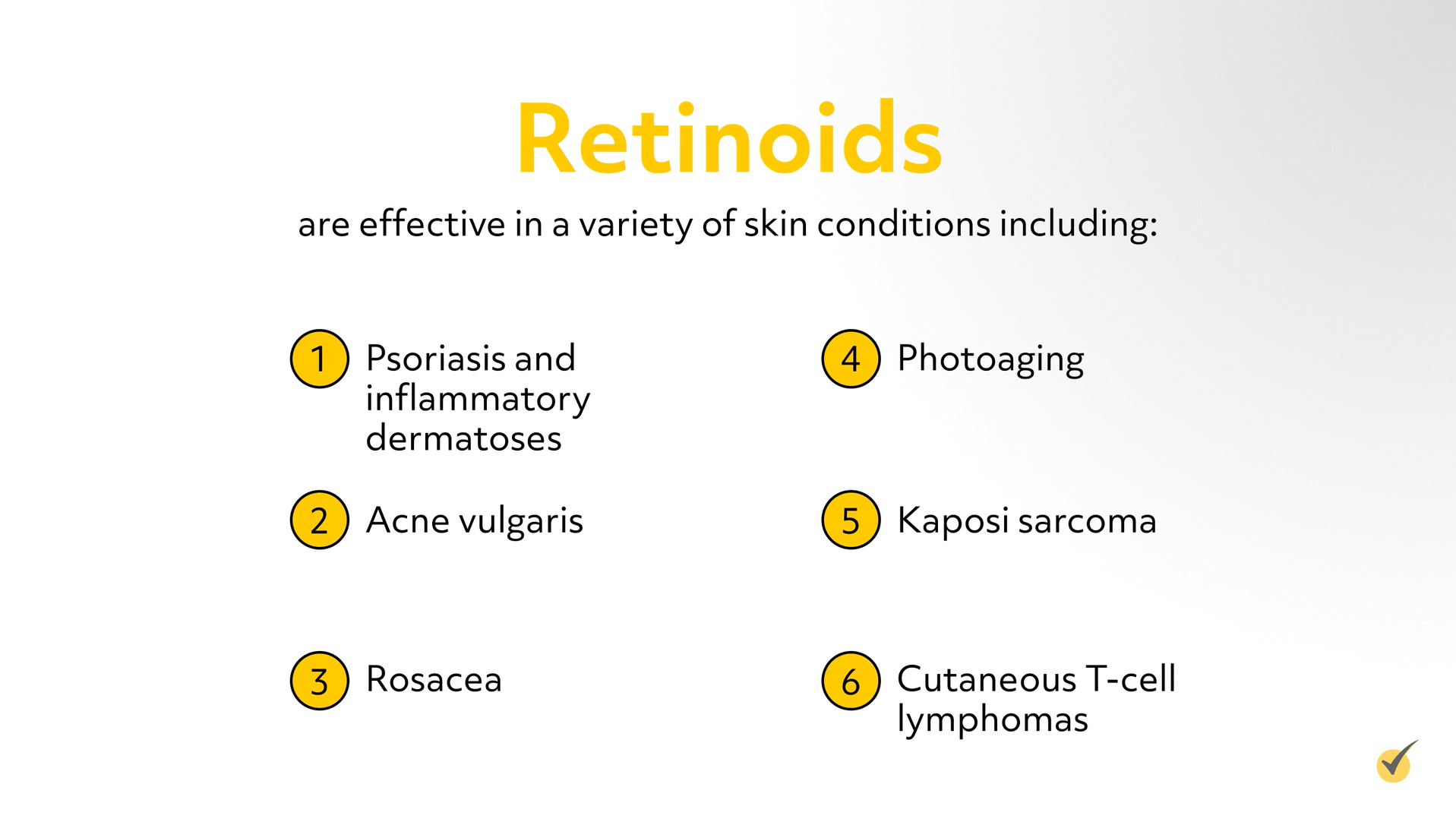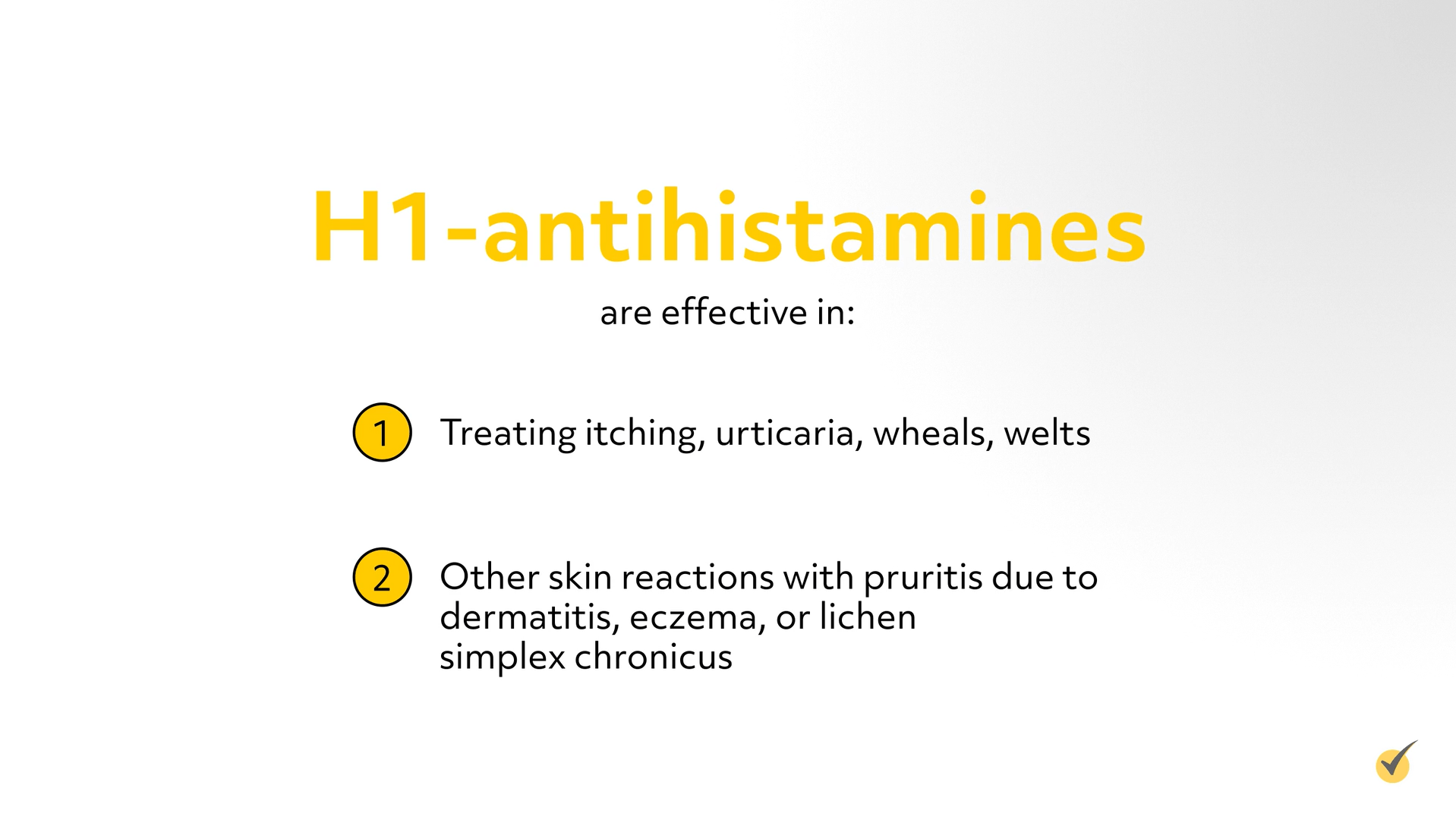
Hi, and welcome to this video on dermatological drugs!
The range of therapeutic modalities available for dermatological conditions are divided into systemic, topical, and physical modalities, as well as surgical therapies. Topical therapy is the most common form of treatment.
Topical Treatments
Topicals are used to deliver medication directly to the affected skin, and are available as creams, ointments, lotions, powders, therapeutic shampoos, and patches. Topical pharmaceuticals used in the management of dermatological disorders include cleansing, moisturizing, exfoliating, debriding, antipruritic agents, astringents, and local anesthetics.
Let’s take a closer look at two common topical treatments: Vitamin D analogues and sunscreens.

Vitamin D Analogues
Vitamin D analogues are synthetic forms of vitamin D3 which have potent anti-proliferative and anti-inflammatory properties. Vitamin D analogues are first-line therapy in the treatment of moderate-to-severe plaque psoriasis and may be used off label in the treatment of other dermatological diseases including: palmoplantar keratosis, pityriasis rubra pilaris, vitiligo, and ichthyosis.
Sunscreen
Sunscreens are divided into two classes based on their mode of action: physical blockers (zinc oxide and titanium oxide) and chemical absorbent sunscreens which contain an active ingredient that absorbs the sun’s UV rays.
Sunscreens are used to prevent skin damage and reduce the risk of developing any of the various skin malignancies associated with UV radiation. It is recommended that a sunscreen with an SPF of 15 or higher and one that offers both UVA and UVB protection be used.
Anti-infectives, Corticosteroids, and Retinoids
Besides topical agents, anti-infective agents, corticosteroids, retinoids, and antihistamines are also used either topically or systemically for skin disorders. The medication regimen, dose, and route are dependent on the nature and extent of the disease being treated.
Anti-infectives include antivirals, antifungals, antibiotics, antiparasitics, and antimalarial agents.

These are used to treat several different types of infections that affect the skin, such as: folliculitis, cellulitis, impetigo, mucocutaneous candidiasis, molluscum contagiosum, onchodermatitis, and warts. Anti-infectives are also used to treat non-infectious skin conditions, including:
- Antibiotics to treat acne, seborrheic dermatitis, rosacea, and pemphigus vulgaris
- Antimalarial agents to treat the cutaneous manifestations of systemic lupus erythematosus (SLE), sarcoidosis, and porphyria cutanea tarda
- Antiviral agents to suppress recurrent skin disorders, such as herpes simplex
Anti-infectives, Corticosteroids, and Retinoids
Corticosteroids (steroids, glucocorticoids or cortisones) are the synthetic analogues of the hormone cortisol and are effective for a variety of immune-mediated skin disorders characterized by inflammation and hyperproliferation of skin cells.

Corticosteroids inhibit cellular proliferation and have anti-inflammatory, immunosuppressive properties making them useful in the treatment of contact dermatitis, eczema, psoriasis, bullous pemphigoid, and lichen planus, as well as other skin conditions.
Topical corticosteroids are divided into 7 classes based on potency, with Class I the most potent and Class VII an OTC preparation of 1% hydrocortisone. They are available as creams, ointments, gels, foams, and lotions, and are the most commonly prescribed agent in the treatment of dermatologic conditions.
Systemic corticosteroids are used to address skin disorders that affect the entire body or for more severe skin conditions; and may be used on a short-term or long-term basis, and can be given orally, intramuscularly, or intravenously. Steroids can also be administered as intralesional injections. The route, dose, frequency, and duration of systemic corticosteroids is carefully planned so that patients receive the lowest dose of steroids necessary for effectiveness.
Retinoids are chemical derivatives of vitamin A and bind selectively to retinoic acid receptors, inhibiting follicular keratinization and the formation of comedones, inflammatory and non-inflammatory eruptions. Retinoids promote exfoliation, induce cell differentiation, and inhibit cell proliferation.

Retinoid treatments increase collagen, elastin and fibrillin production, and decrease collagen destruction, and epidermal melanin content. Retinoids are effective in a variety of skin conditions including: psoriasis and inflammatory dermatoses, acne vulgaris, rosacea, photoaging, Kaposi sarcoma, and cutaneous T-cell lymphomas. Generally, systemic therapy is used in more advanced cases or in severe disease refractory to other treatments.
Antihistamines are drugs in the H1-antihistamine class that are widely used in dermatology to block the action of histamine on the affected tissue. H1-antihistamines are effective in treating itching, urticaria, wheals, welts, and other skin reactions with pruritis due to dermatitis, eczema, or lichen simplex chronicus.

Phototherapy and Surgery
Available for topical use as lotions, sprays, creams, or gels; for oral use as liquids, pills, or capsules; and for intravenous, intradermal, or intramuscular injections.
Another form of treatment for dermatological conditions includes phototherapy. Phototherapy is a treatment that uses specific wavelengths and doses of ultraviolet light (radiation) to treat skin conditions. Phototherapy is used in the treatment of acne vulgaris, psoriasis, atopic dermatitis, papulopustular rosacea, lichen planus, vitiligo, nonmelanoma skin cancers, Kaposi’s sarcomas, decubiti, and other types of skin ulcers.
Light base therapy can either be used alone or in combination with drugs called psoralens; which are given orally or topically prior to the treatment session, or as an adjunct with topical therapies. Typically, phototherapy is used for skin conditions unresponsive to other therapies or as an alternative to systemic immunosuppressive agents. It is often used as maintenance therapy in chronic skin disorders. Phototherapy treatments suppress skin disease activity by selective destruction of abnormal tissue.
There are a variety of light-based treatments, each with a different mechanism of action, but, typically, either ultraviolet A (UVA) and ultraviolet B (UVB) radiation are used for skin disorders. Ultraviolet radiation, like all forms of light, is classified by wavelength and herein lies the key difference; each treatment type uses a specific waveband of ultraviolet radiation.
- Ultraviolet-B (UVB) radiation utilizes shorter wavelengths ranging from 290-320 nanometers (nm), only reaching the outer layer of the skin. It includes broad-spectrum UVB which uses the full spectrum of UVB radiation and the more commonly used narrow-band UVB, wavelengths between 311 to 312 nm. Narrow-band UVB is more intense than broad spectrum UVB and by using a smaller part of the light spectrum avoids some of the more harmful UVB wavelengths.
- Ultraviolet-A (UVA) rays, on the other hand, have a longer wavelength than UVB rays and can penetrate deeper layers of skin. UVA treatment utilizes wavelengths ranging from 320-400 nm and is given together with the drug Psoralen (PUVA), which increases the skin’s sensitivity to the light, improving the effectiveness of the therapy.
UV therapy requires multiple sessions which can range up to 40 sessions, with sessions scheduled from one to five times a week. Treatment starts with a series of increasing doses of UV exposure, over the course of the therapy. Protocols differ for each type of ultraviolet therapy and are not interchangeable.
Depending on the nature of the skin disease, one of the following surgical procedures may be the choice of treatment:
- Cryosurgery is a method of freezing tissues to destroy abnormal or diseased tissue. Tissue is frozen by a cryogenic agent; typically, liquid nitrogen is used. Cryosurgery is used to treat actinic and seborrheic keratosis, viral warts, and precancerous lesions on the skin.
- Electrodesiccation and curettage (ED&C) involves scraping away the skin growth with a curette until healthy skin is encountered and then the site is cauterized (electrodesiccation) to control bleeding and destroys any cancer cells that may remain. ED&C is used to remove some types of cancerous growths, such as basal cell carcinoma and squamous cell carcinoma, seborrheic keratosis, and skin tags.
- Excision involves the removal of the growth and a small amount of normal skin surrounding the growth with either a shave, conservative, or wide excision. Surgical excisions are performed to remove a wide variety of skin lesions ranging from benign epidermal inclusion cysts to all types of malignant skin lesions.
- Mohs surgery is a surgical technique used to remove basal cell carcinoma and/or squamous cell carcinoma in layers, which are then examined under the microscope to determine the extent of the diseased cells before more tissue is removed.
Review Questions
1. Which of the following is not true regarding dermatologic treatments?
- The range of modalities available for the treatment of dermatological conditions are divided into topical, oral, surgical, and physical therapies.
- Treatment protocols differ for each type of ultraviolet therapy and are not interchangeable.
- Retinoids, which are chemical derivatives of vitamin A, inhibit follicular keratinization and cell proliferation.
- Sunscreens, depending on the type, either block or absorb UV radiation from the sun.
Treatment of dermatological conditions are divided into systemic, topical, physical modalities, and surgical therapies.
2. Which statement regarding phototherapy is not true?
- Phototherapy treatments suppress skin disease activity by selective destruction of abnormal tissue.
- Phototherapy is a treatment that uses specific wavelengths and doses of ultraviolet light (radiation) to treat various skin diseases.
- The key difference in UV light treatments is the specific waveband of UV light used.
- Ultraviolet-B (UVB) radiation has a longer wavelength (ranging from 320-400nm) than UVA rays, and can penetrate deeper layers of your skin.
Ultraviolet-B (UVB) radiation utilizes shorter wavelengths ranging from 290-320 nanometers (nm), that reaches only the outer layer of the skin.
3. Which statement best describes the use of Corticosteroids used in the treatment of skin disease?
- Topical corticosteroid agents are used to deliver medication directly to the affected skin and are available only as creams or ointments.
- Systemic corticosteroids are the most commonly prescribed agent in the treatment of dermatologic conditions.
- Corticosteroids are effective for a wide variety of immune-mediated skin disorders that are characterized by inflammation, and hyperproliferation of skin cells; such as eczema and psoriasis.
- Systemic corticosteroids are only used short-term and are given by mouth or intramuscular injection.
Corticosteroids inhibit cellular proliferation and have both anti-inflammatory and immunosuppressive properties making them useful in the treatment of contact dermatitis, eczema, psoriasis, bullous pemphigoid, and lichen planus, as well as other skin conditions.
Thanks for watching, and happy studying!
